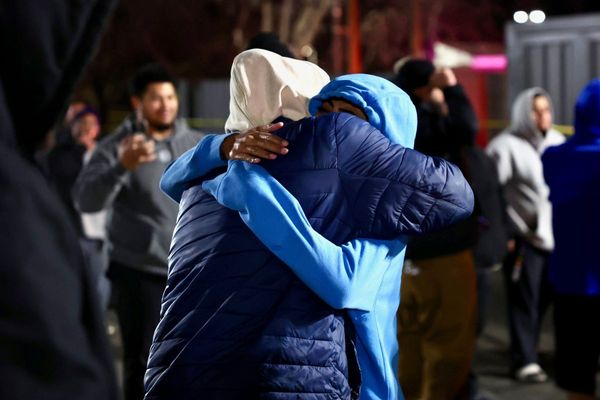
While the Los Angeles-based Blakeney sisters are not officially business partners, they might as well be. The two have long served as each other’s unofficial advisers – whether co-designing spaces, sharing sourcing product tips, offering marketing and promotions advice, or simply acting as each other’s forever-trusted second pair of eyes.
Faith, 46, has emerged as a go-to interior designer for residential clients, indie boutiques and addiction recovery centers. Justina, 44, is the creator of Jungalow, a home decor brand that has put out a range of home design products, books and clothing, and partnered with global retail giants such as Target, Anthropologie and Pottery Barn Kids.
The daughters of a Black father and Jewish mother, the sisters were raised in Berkeley, California, amid distinct-yet-overlapping cultures. “We were lucky to grow up in a really incredible environment for growth and expansion and connection and human development,” says Faith, a single mom to a 17-year-old daughter. (Justina, too, has a daughter, a 10-year-old who every so often appears in her Instagram feed.)
Although the Blakeneys share an affinity for bright colors and bold patterns, they each possess a distinctive design DNA. “Eclectic” is what Faith calls her personal style. Justina describes her designs as inspired “by Mother Nature – filled with botanical motifs and houseplants”. (Almost all of Jungalow’s wallpapers feature plant-like patterns.)
Although nearly 80% of interior designers are women, just 1.5% are Black, according to the online career consultancy Zippia – and that figure has remained flat for almost 15 years, though designers of color are receiving more recognition in a post-George Floyd world. “Sure, we’ve moved the needle – there are more brown people on magazine covers, more collections from designers of color – but how much of this feels like a token and comes from a sense of obligation rather than respect and reparations, I don’t exactly know,” Faith says.
With her appearance last year on the cover of Architectural Digest, Justina’s profile has exploded, despite maintaining a relatively lean operation of 11 staffers. Faith’s practice remains far more modest and client-focused. “My secret sauce in design,” Faith says, “is truly taking time to understand my clients and creating spaces that are an authentic expression of their highest selves.”

Take the downtown Los Angeles loft of Adrien Beard. Although the artist has worked in a wide range of arenas – from film and video games to television shows including South Park – Beard wanted this workspace to evoke his commitment to Black creativity without feeling contrived or heavy-handed. Faith partnered with the interior designer Sachiko Bradley to create a space with African- and African American-inspired murals, carvings and patterns that add up to a look that she dubbed “Neo Afro Eclecticism”. Faith says that her own experience with multiculturalism allowed her to help Beard’s loft reflect the artist’s Blackness – without being limited by it.
The sisters recently came together to work on the new Jungalow pop-up shop in Los Angeles. Faith also joined forces with their younger brother, Yeshaia, 42, on Bottom Bunk – a sneaker shop on Melrose Avenue in Los Angeles. The space, which Faith designed and is perched above the Jungalow pop-up, was opened by two men “who did jail time, got sober and met in recovery”, Faith says – “one of whom happens to be our brother.”
Yeshaia also co-founded and serves as co-CEO of the Recovery Integrity House, a sober-living facility for men, which happens to feature a great many items from Justina’s Jungalow. “It’s a thoroughly family affair,” Faith says.
It possible to maintain boundaries between your businesses and family?
Faith: We are not the kind of family that has a lot of boundaries, which I love and think is a total blessing. Sometimes we are talking about work – and sometimes we will just be home celebrating Shabbat together. The two of us have been partnering together since we graduated from college, moved to Italy and opened a vintage shop in Florence.
Justina: Honestly, there is no need to maintain a wall between our professional and personal relationships. It feels seamless to catch up on how things are going with our kids and then naturally transition to talking about wallpaper patterns.
In which ways do you rely on each other professionally?
Justina: Faith has an ability to help me uncover amazing resources – she turned me on to my executive coach, for instance, who has been a gamechanger for Jungalow and me. She also possesses thoughtful insights, especially with regard to “people stuff” like hiring and difficult [staffing] conversations.

Faith: I’m just good at those kinds of things, but then Justina is very good at other things. She’s extremely tech-savvy – she was an early adopter to all things social media [the Jungalow Instagram has over 2 million followers], whereas I don’t really like spending time on the computer.
How do you choose your clients?
Faith: I don’t really choose my clients, I feel as if it’s more like they choose me. Perhaps because of my cultural background or maybe because of my progressive politics or even because we both love vintage furniture, there is this feeling of “I see you” and “you see me” between my clients and myself – a real sense of kinship.
Faith has described herself as a ‘design healer’ – how does design have the power to heal?
Faith: Working within people’s homes is an incredibly intimate process and I really try to tap into that. People come to me at transition points in their lives – such as a divorce or a first child. There’s one client, a woman in her 40s, who’s single and she’s “calling in her person” – manifesting her true love: her bashert, as the Bible calls it. She hasn’t met him yet, but she knows he is out there. So we are designing the home with space for him in mind as she manifests him.
How do you retain your creativity amid the very real demand for growth?
Justina: There are many ways to interpret the idea of growth. And business growth is merely a piece of that pie. For me, slow, steady, incremental growth with a strong foundation and sturdy infrastructure is the only way to go – and grow.
Faith: I do feel a pressure to grow and I want to grow – yes, in the business arena, but also in the business of being a human. For instance, Justina and I are in a book club with our mother and this has helped my growth tremendously. I have a therapist who supports my growth, a life coach – a phone group of 10 people who speak weekly that I’ve been doing for a decade. All of these things are helping me grow in the broadest possible ways.
What kind of advice would you give to younger talent looking to make design their career?
Faith: I was a single mom new to LA living in a tiny apartment when I began my business. I had a million excuses for why I couldn’t fulfill my dream of opening a design studio. But at a certain point I started to see that my circumstances don’t need to define me.
Justina: Coming up, I often felt like I wasn’t good at business because I felt I wasn’t good at math. But I’ve learned over the years that being good at business has much more to do with being good with people – and not simply just with being good at numbers.
What is the best type of investment to make when embracing design as a career?
Faith: My biggest word of advice is to invest in travel. It expands our consciousness and enriches our lives. Abundance is a state of mind – not a number in a bank account.
Justina: Invest in people – good people, because these are the folks who can help you truly achieve your dreams. You cannot do it by yourself.
What should young designers remember when thinking about a career in design?
Faith: My journey has been incredible, but it has also been bumpy. I’ve been a single mother since my daughter was an infant – there were periods when I was on welfare, periods of deep depression and feelings of isolation; people might see the life I have now and imagine it’s been all beauty and inspiration and travel and success – but no! Along the way, it has been hard!







